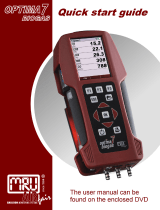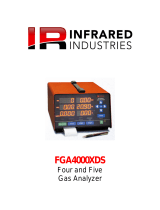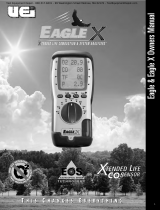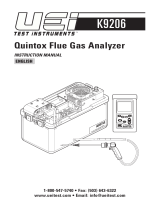Page is loading ...

Portable Emissions Analyzer
Teledyne Analytical Instruments i
OPERATING INSTRUCTIONS FOR
PEM-9004
Portable Emissions Analyzer
DANGER
Toxic gases may be present in this monitoring system.
Personal protective equipment may be required when servicing this instrument.
Hazardous voltages exist on certain components internally which may persist
for a time even after the power is turned off and disconnected.
Only authorized personnel should conduct maintenance and/or servicing.
Before conducting any maintenance or servicing, consult with authorized
supervisor/manager.
P/N MPEM9004
ECO: XX-XXXX

PEM-9004
Teledyne Analytical Instruments ii
Copyright © 2008 Teledyne Analytical Instruments
All Rights Reserved. No part of this manual may be reproduced, transmitted, transcribed,
stored in a retrieval system, or translated into any other language or computer language in
whole or in part, in any form or by any means, whether it be electronic, mechanical,
magnetic, optical, manual, or otherwise, without the prior written consent of Teledyne
Analytical Instruments, 16830 Chestnut Street, City of Industry, CA 91749-1580.
Warranty
This equipment is sold subject to the mutual agreement that it is warranted by us free from
defects of material and of construction, and that our liability shall be limited to replacing or
repairing at our factory (without charge, except for transportation), or at customer plant at
our option, any material or construction in which defects become apparent within one year
from the date of shipment, except in cases where quotations or acknowledgements provide
for a shorter period. Components manufactured by others bear the warranty of their
manufacturer. This warranty does not cover defects caused by wear, accident, misuse,
neglect or repairs other than those performed by Teledyne or an authorized service center.
We assume no liability for direct or indirect damages of any kind and the purchaser by the
acceptance of the equipment will assume all liability for any damage which may result from
its use or misuse.
We reserve the right to employ any suitable material in the manufacture of our apparatus,
and to make any alterations in the dimensions, shape or weight of any parts, in so far as
such alterations do not adversely affect our warranty.
Important Notice
This instrument provides measurement readings to its user, and serves as a tool by which
valuable data can be gathered. The information provided by the instrument may assist the user
in eliminating potential hazards caused by his process; however, it is essential that all
personnel involved in the use of the instrument or its interface, with the process being
measured, be properly trained in the process itself, as well as all instrumentation related to it.
The safety of personnel is ultimately the responsibility of those who control process
conditions. While this instrument may be able to provide early warning of imminent
danger, it has no control over process conditions, and it can be misused. In particular, any
alarm or control systems installed must be tested and understood, both as to how they
operate and as to how they can be defeated. Any safeguards required such as locks, labels,
or redundancy, must be provided by the user or specifically requested of Teledyne at the
time the order is placed.
Therefore, the purchaser must be aware of the hazardous process conditions. The purchaser
is responsible for the training of personnel, for providing hazard warning methods and
instrumentation per the appropriate standards, and for ensuring that hazard warning devices
and instrumentation are maintained and operated properly.
Teledyne Analytical Instruments, the manufacturer of this instrument, cannot accept
responsibility for conditions beyond its knowledge and control. No statement expressed or
implied by this document or any information disseminated by the manufacturer or its
agents, is to be construed as a warranty of adequate safety control under the user’s process
conditions.

Portable Emissions Analyzer
Teledyne Analytical Instruments iii
Specific Model Information
It is not recommended that this instrument be used for analysis on
any other gas or gas mixture than that specified at the time of purchase.
Using this instrument to analyze any other gas mixture may result in
serious error. Consult the factory for additional information for gas
analysis not specified at the time of purchase.
Instrument Serial Number: _______________________

PEM-9004
Teledyne Analytical Instruments iv
Important Notice
The PEM-9004 is a gas analysis computer for measuring and
computing the concentration of various gases in a combustion process.
Both toxic and combustible gasses may at times be present in and
around the analyzer. This instrument is designed to safely handle
specific combustible gas mixtures as outlined in the product
specification. Since Teledyne cannot control the end use of this
instrument, it is the responsibility of the user to establish whether or not
the total system of instrument, environment, alarm components, and any
other relevant devices actually will assure safety under the particular
circumstances of use.
Location of the equipment and sensors that will insure proper
operation is the responsibility of the user.
The safety checklist outlined below is only a guide. It is up to the
user to establish practical safety precautions given his/her own specific
circumstances. It is vital that the operator understand and test the
operation of the total system.
Safety Checklist
Verify that the instrument is powered correctly.
Verify that the instrument works properly (all functions).
Verify that measured values are correct.
Verify that unauthorized personnel cannot tamper with the
instrument or its auxiliary equipment.
Institute routine test/calibration procedures.
Identify and handle any potential problems in sampling or
location.
Train all operators to understand all operations and functions
of the analyzer and the system.
Identify and handle any environmental or other influences that
could affect the operation of the instrument.

Portable Emissions Analyzer
Teledyne Analytical Instruments v
Safety Messages
Your safety and the safety of others is very important. We have
provided many important safety messages in this manual. Please read
these messages carefully.
A safety message alerts you to potential hazards that could hurt you
or others. Each safety message is associated with a safety alert symbol.
These symbols are found in the manual and inside the instrument. The
definition of these symbols is described below:
GENERAL WARNING/CAUTION: Refer to the instructions
for details on the specific danger. These cautions warn of
specific procedures which if not followed could cause bodily
Injury and/or damage the instrument.
CAUTION: HOT SURFACE WARNING: This warning is
specific to heated components within the instrument. Failure
to heed the warning could result in serious burns to skin and
underlying tissue.
WARNING: ELECTRICAL SHOCK HAZARD: Dangerous
voltages appear within this instrument. This warning is
specific to an electrical hazard existing at or nearby the
component or procedure under discussion. Failure to heed this
warning could result in injury and/or death from
electrocution.
Technician Symbol: All operations marked with this symbol
are to be performed by qualified maintenance personnel only.
NOTE: Additional information and comments regarding a
specific component or procedure are highlighted in the form
of a note.
CAUTION: THE ANALYZER SHOULD ONLY BE USED FOR THE
PURPOSE AND IN THE MANNER DESCRIBED IN
THIS MANUAL.
No
Symbol

PEM-9004
Teledyne Analytical Instruments vi
IF YOU USE THE ANALYZER IN A MANNER OTHER
THAN THAT FOR WHICH IT WAS INTENDED,
UNPREDICTABLE BEHAVIOR COULD RESULT
POSSIBLY ACCOMPANIED WITH HAZARDOUS
CONSEQUENCES.
This manual provides information designed to guide you through
the installation, calibration operation and maintenance of your new
analyzer. Please read this manual and keep it available.
Occasionally, some instruments are customized for a particular
application or features and/or options added per customer requests.
Please check the front of this manual for any additional information in
the form of an Addendum which discusses specific information,
procedures, cautions and warnings that may be peculiar to your
instrument.
Manuals do get lost. Additional manuals can be obtained from
Teledyne at the address given in the Appendix. Some of our manuals are
available in electronic form via the internet. Please visit our website at:
www.teledyne-ai.com.

Portable Emissions Analyzer
Teledyne Analytical Instruments vii
Table of Contents
List of Figures................................................................................x
List of Tables................................................................................xi
Introduction ...................................................................................1
1.1 Overview 1
1.2 Features 3
1.3 Operator Interface 4
Operational Theory .......................................................................5
2.1 Introduction 5
2.2 Sensor Cell 5
2.3 Specific Sensor Network 6
2.4 Combustion Efficiency 6
2.4.1 Calculating the CO
2
Composition of Exhaust Gas 6
2.4.2 Calculating the Waste Gas Loss 7
2.4.3 Calculating the Combustion Efficiency 7
2.4.4 Calculating Excess Air Value (Lambda) 8
2.4.5 Calculating Undiluted CO Concentration 9
2.5 Sample System 9
Installation ...................................................................................13
3.1 Unpacking the Analyzer 13
3.2 Attaching the Probe and Thermocouples 13
3.3 Initial Calibration 14
3.4 Battery Power 15
3.4.1 Charging the Battery 15
3.4.2 Battery Replacement 16
3.5 Sensor Replacement 16
Operation .....................................................................................17

PEM-9004
Teledyne Analytical Instruments viii
4.1 User Interface 17
4.2 Startup Screen 19
4.3 Main menu 20
4.3.1 Status Line 20
4.3.2 Available Programs 20
4.4 Configure Menu 21
4.4.1 Display 21
4.4.2 Fuel 23
4.4.2.1 Remove a Fuel from the List 23
4.4.2.2 Reinstate a Previously Removed Fuel 23
4.4.2.3 Insert a New Fuel 24
4.4.3 Settings 26
4.4.3.1 Units for Draft and Pressure 26
4.4.3.2 Instrument Sound On/Off 26
4.4.3.3 Select Printer 27
4.4.3.4 User Address 27
4.4.3.5 Automatic Timer 28
4.4.4 Set Default 29
4.5 Measurement Screen 30
4.5.1 Flue Gas 31
4.5.1.1 Draft 32
4.5.1.2 Info 33
4.5.1.3 Draught Detection 34
4.5.1.4 Units 35
4.5.1.5 O
2
Referenece 36
4.5.1.6 Extended Data 36
4.5.1.7 Graphic 39
4.5.1.8 Fuel 40
4.5.1.9 Config 40
4.5.1.10 Program Macros 40
4.5.1.11 Hold 41
4.5.1.12 Zoom 42

Portable Emissions Analyzer
Teledyne Analytical Instruments ix
4.5.1.13 CO Protect 43
4.5.1.14 Print 44
4.5.2 Temperature 45
4.5.3 Pressure 46
4.5.4 CO (O
2
) Measurement 47
4.6 Macro Start 48
4.7 Time-Date 49
4.8 Memory 51
4.9 USB-Interface 54
4.10 Charge Control 54
4.11 Battery / Line Voltage Operation 55
4.11.1 Charging the Battery 55
4.11.2 Battery Replacement 56
Maintenance.................................................................................57
5.1 Routine Maintenance 57
Appendix......................................................................................59
Specifications 59
Recommended Spare Parts List 62
Reference Drawings 63
Index.............................................................................................65

PEM-9004
Teledyne Analytical Instruments x
List of Figures
Figure 2-4: Gas Conditioning System ...........................................10
Figure 3-1: PEM-9004 Front Panel ...............................................14
Figure 4-1: PEM-9004 Front Panel ...............................................17
Figure 4-2: Additional Functions Available from Flue Gas Menu...19
Figure 4-3: Data Memory Structure...............................................52
Figure 5-1 Water Trap and Filter...................................................58

Portable Emissions Analyzer
Teledyne Analytical Instruments xi
List of Tables
Table 1-1: Measurement Capabilities of the PEM-9004 Analyzer...2
Table 1-2: Parameters Calculated by the PEM-9004......................2
Table 4-1: Function Keys...............................................................18

PEM-9004
Teledyne Analytical Instruments xii
DANGER
COMBUSTIBLE GAS USAGE
WARNING
It is the customer's responsibility to ensure safety especially
when combustible gases are being analyzed since the
potential of gas leaks always exist.
The customer should ensure that the principles of operating
of this equipment is well understood by the user and that the
instrument as well as any approved support equipment is
properly installed. Misuse of this product in any manner,
tampering with its components, or unauthorized substitution
of any component may adversely affect the certification and
the safety of this instrument.
Since the use of this instrument is beyond the control of
Teledyne, no responsibility by Teledyne, its affiliates, and
agents for damage or injury from misuse or neglect of this
equipment is implied or assumed.

Portable Emissions Analyzer Introduction
Teledyne Analytical Instruments 1
Introduction
1.1 Overview
The Teledyne Analytical Instruments (TAI) Model PEM-9004 Gas
Analysis Computer is a multifunction analyzer with integrated
calculating functions. The system is ideally suited for monitoring
heaters, exhaust lines, and other flue gas installations.
The PEM-9004 analyzes the gaseous products of a combustion
process and provides critical information on the state of the effluent
stream. Information is available on-screen and via printed reports. Data
can also be output to a remote device via the USB communication port.
The system is battery operated, lightweight yet rugged so it can be
moved and rapidly setup at any location.
The analyzer measures and displays the O
2
, CO, and with the
appropriate option, SO
2
, and NO content of a gas. It also senses and
measures draft or pressure and the gas temperature at the sampling point
as well as the ambient temperature. An internal database of common
fuels supplies thermodynamic data for calculations that the monitor
performs on the sampled data, to determine the CO
2
and NO
x
concentrations when equipped with the appropriate optional sensors.
The instrument also calculates combustion efficiency, excess air and
other parameters critical in assessing efficiency in a combustion process.
Measured data and test results can be stored in a 100 record
database for later recall and printed on demand from the monitor’s
integral printer. Data can also be monitored remotely via an integral
USB communications port. Numerical data can be output in a variety of
units for customer reports.
Gas and electrical ports along with the display and all operator
controls are accessible from the front panel.
Table 1-1 and 1-2 highlight the PEM-9004 monitoring capability.
They show the actual measured parameters and derived (calculated)
values respectively.

Introduction PEM-9004
Teledyne Analytical Instruments 2
Table 1-1: Measurement Capabilities of the PEM-9004 Analyzer
Measured
Values
T.Gas Waste or flue gas
temperature
°F or °C
T.Room Air or ambient
temperature
°F or °C
O2 Oxygen content % Volume
CO Carbon monoxide ppm-mg/mm
3
-mg/kWh
NO Nitrogen monoxide
(option)
ppm-mg/mm
3
-mg/kWh
SO2 Sulphur dioxide
(option)
ppm-mg/mm
3
-mg/kWh
Draft Draft or Pressure inches of H
2
0 (iWC)
Table 1-2: Parameters Calculated by the PEM-9004
Calculated
Values
CO2 Carbon dioxide % Volume
CO 0% Carbon monoxide,
undiluted
ppm
Effi. Combustion efficiency %
Ex.air Excess air value
qA Waste gas losses %
Dewpnt Fuel specific dewpoint °F or °C
T.Diff Differential temperature
(TG-TA)
°F or °C
NOx Nitrogen oxides (option) ppm-mg/mm
3
-mg/kWh
NOx ref. Nitric oxides, undiluted
(option)
ppm
SO2 ref. Sulphur dioxide,
undiluted (option)
ppm

Portable Emissions Analyzer Introduction
Teledyne Analytical Instruments 3
1.2 Features
• Analysis Ranges: The PEM-9004 is available with the
following analysis ranges:
• O
2
0-20.9%
• CO 0-4000 ppm
(with H
2
compensation)
• CO
2
(calculated from O
2
measurement)
0-CO
2
max (fuel specific)
And optionally:
• CO 0-2% (0-20,000 ppm)
(without H
2
compensation)
• NO 0-2000 ppm (optional)
• SO
2
0-2000 ppm (optional)
• NO
2
0-200 ppm
• CO Sensor Protection: The PEM-9004 incorporates a special
CO sensor protection feature utilizing a separate pump that
automatically flushes the CO sensor when an upper CO
threshold of 4000 ppm is exceeded.
• Pressure/Draft Measurement: A piezoresistive pressure
sensor with internal temperature compensation is installed for
measuring pressure up to ± 60 inches of water (iWC). A
convenient port is located on the front panel for positive or
negative pressure measurements.
• Temperature Measurement: Both ambient and gas
temperatures up to 1850°F (1000°C) are monitored using K-
type (NiCr-Ni) thermocouples. These parameters are used by
the internal processor in calculating combustion efficiency,
waste gas loses, excess air and undiluted CO concentration.
• Waste Gas Sampling: Via an external water separator and
filter, the waste gas is fed to the sensors by means of a gas
feed pump. It accepts either a one point measurement probe
(combi-probe) or multi-point measurement probe (multi-hole
probe).

Introduction PEM-9004
Teledyne Analytical Instruments 4
• Unit Conversion: Gas, temperature and pressure information
is displayed and/or stored in several different units depending
on the user’s preference.
• Internal Infrared Thermal Printer: The PEM-9004 is
equipped with a printer for immediate hard copy of data. If
desired, the printed reports can contain a header with the
company name or other convenient designation.
• Display: Hi-res LCD module with 5 or 10 line text and
graphical display plus menu line.
• Data Communication: USB interface. Optional radio-
interface (Bluetooth).
• Memory: 100 memory blocks max. including dynamic
memory management and directory/file structure.
• Power: NiCd battery 6V/4Ah with external power adapter and
charger. Integral power management system controls battery
charging and prolongs battery life.
1.3 Operator Interface
All user controls and connections are accessible from the front
panel after opening the top case. Figure 1 shows the front panel of the
PEM-9004. There are 3 function buttons and 7 menu select buttons (also
referred to as keys) which control all operations of the analyzer. Chapter
4 describes in detail the use of the menu select and function buttons in
operating the analyzer. In addition to operator controls, gas and
thermocouple ports are installed and clearly identified on the front panel.

Portable Emissions Monitor Operational Theory
Teledyne Analytical Instruments 5
Operational Theory
2.1 Introduction
The PEM-9004 uses state-of-the-art sensor technology for accurate
measurements of O
2
, CO/H
2
, CO-high and optionally, NO and SO
2
. The
sensors employed are electrochemical cells specific for each component.
The instrument will measure and display the actual gas
concentration for O
2
and CO(H
2
). Depending on the options selected at
the time of purchase, the PEM-9004 can also measure and display the
NO, CO (high), and SO
2
concentration of a flue gas. The analyzer, based
on measurements of draft pressure, temperature, and data entered for the
combustion fuel plus pertinent thermodynamic data internally stored as
part of the instrument’s database, will calculate and display the
following combustion related information:
• CO
2
concentration
• Non-diluted CO concentration
• Pressure and temperature differential
• Efficiency (Eta)
• Waste gas losses (qA)
• NOx concentration
• Dew point
• Eta combustion value
2.2 Sensor Cell
At the heart of the analyzer are the sensors. Up to 5 sensor cells are
installed depending on the options selected at the time of purchase. Each cell
is specific to a particular gaseous component.

Operational Theory PEM-9004
Teledyne Analytical Instruments 6
2.3 Specific Sensor Network
The sensors employed in the PEM-9004 operate according to
Faraday's Law of Electrolysis: In an electrochemical cell, the rate at which
gas is produced at one pole is directly proportional to the quantity of
electric current flowing through the electrodes. Conversely, the current
produced by the cell is directly proportional to the consumption of gas at
the pole.
The PEM-9004 incorporates a network of up to five individual sensors
for analyzing oxygen, carbon monoxide, and optionally, sulphur dioxide,
and nitrogen oxides. The individual sensors are arranged on a sensor block
located underneath the front panel of the unit. Each sensor produces an
output current proportional to the consumption rate of the particular gas for
which it is sensitive. Typically, the sensor output is in the microampere
range. Cross-sensitivity between sensors is measured and corrected for,
using an internal algorithm. The sensor output is fast and stable and only
mildly affected by changes in relative humidity or temperature.
2.4 Combustion Efficiency
The PEM-9004 measures oxygen, combustion gas temperature,
draft pressure and ambient air temperature, and it contains an internal
database of the thermodynamic properties of several common fuels. It
uses these to calculate combustion efficiency as follows:
2.4.1 Calculating the CO
2
Composition of Exhaust Gas
It first calculates the CO
2
composition of the exhaust gas on a dry
basis using data extracted from the selected fuel. The following equation
is used to calculate the CO
2
concentration in volume %.
Where: CO
2MAX
is the fuel specific theoretical maximum CO
2
concentration in volume %
O
2
is the measured oxygen concentration in volume %
20.9 is the oxygen content in air (volume %).
⎟
⎠
⎞
⎜
⎝
⎛
−×=
9.20
O
1COCO
2
22
MAX

Portable Emissions Monitor Operational Theory
Teledyne Analytical Instruments 7
2.4.2 Calculating the Waste Gas Loss
The analyzer uses the measured oxygen concentration and the
exhaust gas and ambient temperature of the stack to calculate the total
energy loss in the exhaust gas. The total energy loss is calculated by
adding in the work done to expand the exhaust gas against atmospheric
pressure and the heat required to vaporize the water generated in the
burning process.
The waste gas loss calculation involves multiplying the heat
capacity of each component by the difference in temperature between
ambient air and exhaust gas. The following equation is used to calculate
the waste gas loss (qA) in %:
Where: T
gas
is the waste/flue gas temperature in °F or °C
T
air
is the combustion ambient temperature in °F or °C
A2 and B are fuel-specific factors stored internally in the
PEM-9004 database.
2.4.3 Calculating the Combustion Efficiency
The combustion efficiency of a combustion process is determined
from the relation:
Efficiency = (E
fuel
- E
lost
) 100
The instrument subtracts the waste gas loss as previously calculated
for a specific fuel from the total energy of the selected fuel to arrive at
the overall combustion efficiency (Eta). The PEM-9004 uses the
following equation:
Where: Eta is the combustion efficiency expressed as a
percentage.
qA is the heat loss calculated for the given fuel.
⎟
⎟
⎠
⎞
⎜
⎜
⎝
⎛
+×= B
A
2
airgas
-O21
2
)T-(TqA
qA-100Eta
=

Operational Theory PEM-9004
Teledyne Analytical Instruments 8
The calculation is done on a dry basis. This means that the term
representing the energy necessary to heat the water vapor from ambient
to exhaust temperature is omitted.
To obtain the precise value for combustion efficiency one must
account for many variables. The most important are:
• Radiative heat losses
• Variation in fuel composition
• Air that leaks into the flue gas mixture raising oxygen
reading
• Heat loss in ash
• Incomplete combustion
• Boiler blowdown.
The PEM-9004 necessarily makes simplifying assumptions in its
determination of efficiency. Therefore it must be considered a trend
indicator that will correctly show an increase or decrease in efficiency,
whereas the absolute value of the number applies to the ideal case only.
2.4.4 Calculating Excess Air Value (Lambda)
The minimum amount of air that supplies sufficient oxygen for the
complete combustion of a fuel is referred to as the theoretical or
stoichiometric amount of air. Most combustion processes involve an
amount of air different than stoichiometry requires. The differential is
called
excess air and can be a positive or negative amount. The
stoichiometric requirement for air depends on the type of fuel used and
to a lesser extent, the temperature and pressure of the reaction. Nitrogen
is normally considered unaltered in lower temperature reactions and
simply adds to the heat balance of the combustion process. As the
combustion temperature increases however, increasing amounts of
nitrogen oxides are formed which must be considered in the overall
chemical balance.
In the PEM-9004, the excess air (Lambda) value is calculated from
the ratio of CO
2max
to CO
2observed
as follows:
22
2MAX
O9.20
9.20
CO
CO
Lambda
−
==
/


















